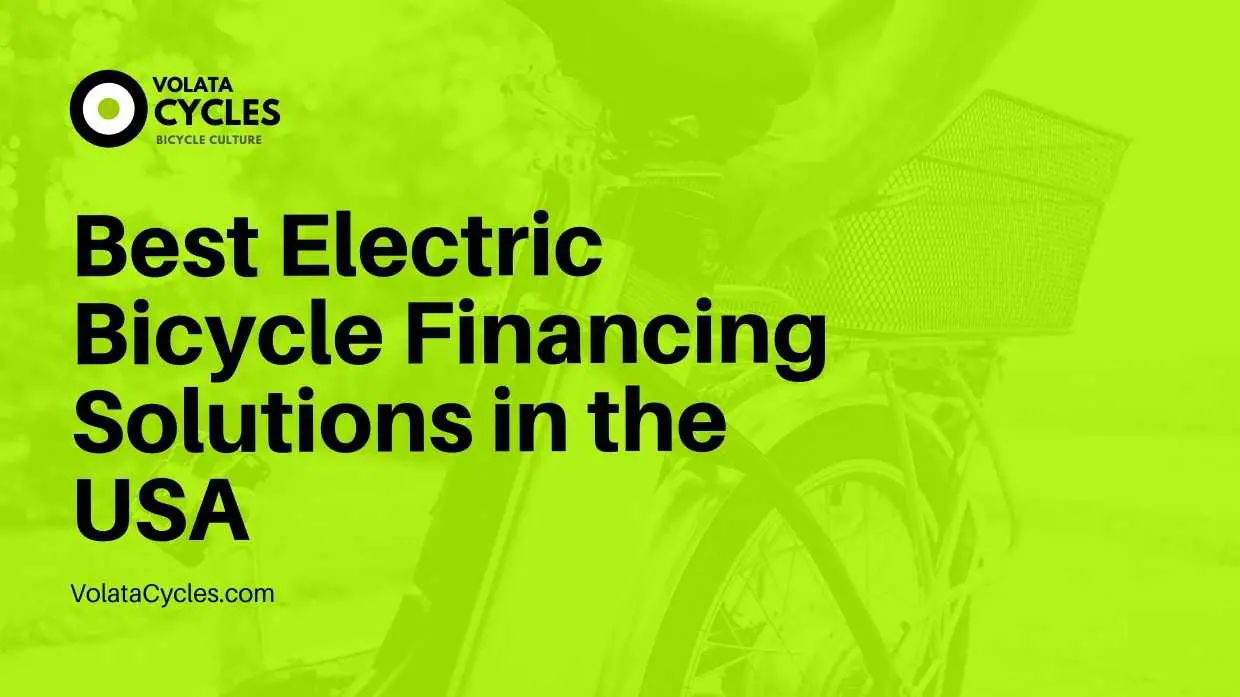Understanding eBike Financing: An Overview
eBike financing options have emerged as a popular solution for individuals seeking to invest in an electric bicycle without the upfront financial burden. The growing popularity of eBikes, coupled with their potential to revolutionize urban transportation, has led to a surge in demand for flexible financing options. eBike financing allows you to spread the cost of your electric bicycle over a period of time, making it an accessible and affordable choice for a wide range of consumers.

Top Financing Options for eBikes
When exploring eBike financing options, it’s essential to consider various factors such as interest rates, terms, and application processes. Here are some of the best financing options available for electric bicycles:
Traditional Bank Loans
Many banks offer personal loans that can be used for eBike financing. These loans typically come with fixed interest rates and terms, allowing you to budget your monthly payments effectively. To apply, visit your local bank’s website or branch and inquire about their personal loan options. Ensure that you have a good credit score to secure a favorable interest rate.
Credit Cards
Using a credit card for eBike financing can be an option, especially if you can take advantage of a 0% introductory APR period. However, be aware that interest rates can be high once the promotional period ends. Always pay your bills on time to avoid late fees and potential damage to your credit score.
Online Lenders
Numerous online lenders specialize in consumer loans, including eBike financing. Online lending platforms often provide fast approval times and competitive interest rates. Some popular online lenders include Upstart, Avant, and Marcus by Goldman Sachs. Carefully review the terms and conditions before applying.
eBike-Specific Financing Platforms
Some eBike manufacturers and retailers offer in-house financing options tailored to electric bicycles. These platforms often provide flexible terms and competitive interest rates. Examples include the Pedal Revolution Finance program by Rad Power Bikes and the financing options offered by Aventon Bikes. Research various eBike brands and retailers to find financing options that suit your needs.
Peer-to-Peer Lending
Peer-to-peer lending platforms, such as LendingClub and Prosper, connect borrowers directly with investors. These platforms can offer competitive interest rates and terms, making them an attractive option for eBike financing. However, be prepared to pay origination fees and potentially face stricter credit score requirements.

How to Choose the Right eBike Financing Option
Selecting the ideal eBike financing option requires careful consideration of various factors. By following these steps, you can make an informed decision that aligns with your budget, credit score, and long-term financial goals:
Step 1: Determine Your Budget
Begin by establishing a budget for your eBike purchase. Consider your monthly income and expenses to determine an affordable monthly payment. Keep in mind that eBikes can range in price from a few hundred to several thousand dollars, so it’s crucial to have a clear idea of how much you can comfortably spend.
Step 2: Assess Your Credit Score
Your credit score plays a significant role in determining the interest rates and terms you’ll qualify for when financing an eBike. If your credit score is less than ideal, you may want to consider improving it before applying for financing. This can help you secure a more favorable interest rate and lower your overall financing costs.
Step 3: Research Financing Options
Explore various eBike financing options, including traditional bank loans, credit cards, online lenders, eBike-specific financing platforms, and peer-to-peer lending. Compare their terms, interest rates, and application processes to find the best fit for your needs.
Step 4: Evaluate Long-Term Financial Goals
Consider your long-term financial goals when selecting an eBike financing option. For instance, if you plan to pay off your loan quickly, a shorter-term loan with a higher monthly payment may be more suitable. However, if you prefer lower monthly payments, a longer-term loan may be a better choice. Remember that longer-term loans often come with higher interest rates, increasing your overall financing costs.
Step 5: Compare Interest Rates
Interest rates can significantly impact the total cost of eBike financing. Always compare interest rates from different lenders to ensure you’re getting the best deal. Keep in mind that some lenders may offer promotional interest rates or discounts for first-time borrowers, so be sure to inquire about any available deals.
Step 6: Read Reviews and Gather Recommendations
To gain insight into the experiences of other eBike financing customers, read online reviews and gather recommendations from friends, family, or colleagues who have financed electric bicycles. This information can help you make a more informed decision about which financing option to choose.
Step 7: Prepare Necessary Documents
Before applying for eBike financing, gather all necessary documents, such as proof of income, tax returns, and bank statements. Having these documents ready can streamline the application process and increase your chances of approval.
Step 8: Maintain Good Credit
Throughout the financing process, it’s essential to maintain good credit by paying your bills on time and avoiding unnecessary debt. This can help you secure better financing terms in the future and ensure a smooth eBike financing experience.

eBike Financing vs. Buying Outright: Pros and Cons
When considering the purchase of an electric bicycle, potential buyers often face the decision of whether to finance the eBike or buy it outright. Both approaches have their advantages and disadvantages, which should be carefully weighed before making a decision. Here, we will explore the pros and cons of eBike financing options and buying an electric bicycle outright in terms of cost, convenience, and accessibility.
Cost
eBike Financing: Financing an eBike allows you to spread the cost over time, making it more manageable for those with limited upfront funds. Additionally, some financing options may offer promotional interest rates or discounts, reducing the overall financing cost.
Buying Outright: Purchasing an eBike outright eliminates the need to pay interest, resulting in a lower total cost. However, this approach may require significant upfront savings, which might not be feasible for all buyers.
Convenience
eBike Financing: Financing an eBike provides the convenience of smaller, regular payments, which can be more easily incorporated into a monthly budget. This approach also allows buyers to purchase a higher-quality eBike than they might otherwise be able to afford.
Buying Outright: Buying an eBike outright can be more convenient for those who have the necessary funds available, as it eliminates the need to apply for financing and make regular payments. However, this approach may limit the buyer’s options to lower-priced eBikes.
Accessibility
eBike Financing: Financing an eBike can make it more accessible to a wider audience, including those who may not have the immediate funds to purchase an eBike outright. This can help promote the adoption of electric bicycles as a sustainable and healthy transportation option.
Buying Outright: Purchasing an eBike outright can be less accessible for those without sufficient savings. However, this approach can still be a viable option for those with the financial means to do so.
Ultimately, the decision to finance an eBike or buy it outright depends on individual financial circumstances, preferences, and long-term goals. By carefully considering the pros and cons of each approach, potential eBike buyers can make an informed decision that best suits their needs.
Real-Life Examples: Success Stories from eBike Financing
eBike financing has enabled numerous individuals to access the benefits of electric bicycles, transforming their daily commutes and recreational activities. By sharing inspiring success stories, we aim to highlight the positive impact that eBike financing can have on people’s lives and mobility.
Enhancing Commutes and Reducing Carbon Footprints
Meet Sarah, a marketing professional living in a bustling city. She wanted to find a more sustainable and cost-effective way to commute to work, but her budget didn’t allow for an outright eBike purchase. By financing her eBike, Sarah was able to reduce her carbon footprint and save money on public transportation while enjoying a more comfortable and convenient commute.
Expanding Recreational Opportunities
John, an avid cyclist, dreamed of exploring off-road trails but found traditional bicycles too challenging due to his knee issues. Financing an eBike allowed him to access the power-assisted pedaling feature, which enabled him to enjoy his favorite hobby without causing undue strain on his joints. As a result, John has discovered new trails and expanded his recreational opportunities.
Promoting Healthy Aging
Mary, a senior citizen, was looking for a low-impact exercise option to maintain her physical health. She found that eBikes offered the perfect balance between staying active and minimizing strain on her joints. By financing her eBike, Mary has been able to improve her overall well-being and enjoy the outdoors with friends and family.
These success stories demonstrate the transformative power of eBike financing options. By making electric bicycles more accessible and affordable, financing solutions can positively impact individuals’ lives, promoting sustainable transportation, enhancing recreational opportunities, and encouraging healthy aging.

Navigating the Application Process for eBike Financing
Applying for eBike financing can be a straightforward process if you are well-prepared and understand the requirements. Here, we provide practical tips and advice on completing eBike financing applications, addressing common challenges and misconceptions. By following these guidelines, you can increase your chances of securing the best financing option for your needs.
Preparing Necessary Documents
Before starting the application process, gather essential documents, such as proof of income, recent tax returns, and bank statements. Lenders may also require information about your current debts and living expenses. Having these documents ready will streamline the application process and demonstrate your financial responsibility.
Maintaining Good Credit
A good credit score is crucial when applying for eBike financing. Lenders often view applicants with higher credit scores as lower-risk, potentially offering better terms and lower interest rates. If your credit score needs improvement, consider taking steps to boost it before applying for financing. Paying bills on time, reducing debt, and checking your credit report for errors can help improve your credit score.
Comparing Financing Options
Research various eBike financing options to find the best fit for your budget and financial goals. Compare terms, interest rates, and application processes to ensure you are making an informed decision. Remember that the lowest interest rate isn’t always the best option if it comes with strict terms or high fees.
Understanding Application Fees and Other Costs
Some lenders may charge application fees or origination fees for processing your loan. Be sure to factor these costs into your decision-making process. Additionally, consider any penalties for early repayment, as these can significantly impact your long-term financial goals.
Addressing Misconceptions
Some applicants may believe that financing an eBike is overly complicated or time-consuming. However, many lenders now offer online applications, making the process quick and convenient. Additionally, eBike financing platforms often provide dedicated support teams to guide you through each step, ensuring a smooth and hassle-free experience.
Navigating the eBike financing application process becomes more manageable with proper preparation and understanding. By gathering necessary documents, maintaining good credit, comparing financing options, and addressing misconceptions, you can secure the best financing solution for your electric bicycle.

Maintaining Your eBike: Tips for Long-Term Care
Investing in eBike financing options allows you to enjoy the benefits of electric bicycles without a significant upfront cost. However, it’s essential to maintain your eBike in good condition to ensure its longevity and optimal performance. Proper care can also lead to cost savings in the long run, as neglected eBikes may require expensive repairs or replacements. Here, we provide guidance on maintaining your eBike, emphasizing the importance of regular maintenance and the potential cost savings associated with proper care.
Follow the Manufacturer’s Recommendations
Consult your eBike’s user manual for specific maintenance guidelines, including recommended tire pressure, chain lubrication, and battery care. Adhering to these recommendations can help extend the life of your eBike and prevent unnecessary wear and tear.
Regular Cleaning and Inspections
Clean your eBike regularly to remove dirt, debris, and grime that can accumulate in moving parts. Inspect your eBike for any signs of damage, such as worn-out tires, frayed brake cables, or loose bolts. Addressing these issues promptly can prevent more significant problems down the road.
Proper Battery Care
The battery is one of the most critical components of an eBike. Proper care can significantly impact your eBike’s range, performance, and lifespan. Store your eBike in a cool, dry place, and avoid exposing the battery to extreme temperatures. Regularly charge your battery according to the manufacturer’s guidelines, and consider using a smart charger to optimize charging efficiency.
Regular Tune-Ups
Schedule routine tune-ups with a professional eBike mechanic to ensure your bike is in top condition. A professional can identify potential issues before they become major problems, saving you time and money in the long run. Regular tune-ups can also help maintain your eBike’s warranty, ensuring coverage for any unexpected repairs.
Cost Savings from Proper Maintenance
Investing in regular maintenance can lead to significant cost savings over time. Preventative care can help extend the life of your eBike’s components, reducing the need for expensive repairs or replacements. Additionally, a well-maintained eBike is more energy-efficient, requiring less power to operate and reducing battery replacement costs.
Maintaining your eBike is crucial for ensuring its longevity, performance, and cost-effectiveness. By following the manufacturer’s recommendations, regularly cleaning and inspecting your eBike, properly caring for the battery, scheduling routine tune-ups, and understanding the cost savings associated with proper maintenance, you can enjoy the benefits of eBike financing options while maximizing your investment.

Expanding Access to eBike Financing: The Future of Electric Bicycle Mobility
As eBikes continue to gain popularity, the need for accessible and affordable financing options has become increasingly evident. The future of eBike financing is ripe with potential developments and innovations that could make electric bicycles more accessible to a wider audience. This section explores emerging trends and possibilities in eBike financing, emphasizing the potential benefits for consumers and the electric bicycle industry.
Integration with Micromobility Subscription Services
The rise of subscription-based micromobility services, such as e-scooter and e-bike sharing programs, presents an opportunity for integrating eBike financing options. By offering eBikes as part of a monthly subscription package, consumers can enjoy the benefits of electric bicycles without the upfront cost or long-term commitment. This model could also include maintenance, insurance, and upgrade options, providing a comprehensive and convenient solution for electric bicycle transportation.
Collaboration with Employers and Commuter Programs
Employers and commuter programs are increasingly recognizing the benefits of eBikes for employee well-being and transportation. Collaborating with these organizations to offer eBike financing options can make electric bicycles more accessible to employees, encouraging active commuting and reducing traffic congestion. Employers may also consider offering incentives, such as subsidies or reimbursements, to further promote eBike adoption.
Innovative Financing Models and Partnerships
The growth of eBike financing options has led to the emergence of innovative financing models and partnerships. For example, some manufacturers and retailers have partnered with financial institutions to offer specialized eBike loans with competitive interest rates and flexible repayment terms. Additionally, peer-to-peer lending platforms and crowdfunding campaigns can provide alternative financing sources for eBikes, expanding access to a broader audience.
Government Incentives and Subsidies
Governments worldwide are recognizing the potential benefits of eBikes, including reduced traffic congestion, improved air quality, and increased physical activity. As a result, various incentives and subsidies are being introduced to promote eBike adoption. These initiatives can include tax credits, rebates, and grants for eBike purchases, making electric bicycles more affordable for consumers and encouraging sustainable transportation.
Technological Advancements and Cost Reductions
Technological advancements and cost reductions in eBike components, such as batteries and motors, can contribute to more affordable eBike financing options. As the cost of producing electric bicycles decreases, manufacturers and retailers may pass these savings onto consumers, making eBikes more accessible to a wider audience. Additionally, innovations in eBike sharing and rental programs can further expand access to electric bicycles, encouraging sustainable transportation and reducing the need for private vehicle ownership.
The future of eBike financing is filled with potential developments and innovations that could make electric bicycles more accessible and affordable for a wider audience. By exploring integration with micromobility subscription services, collaboration with employers and commuter programs, innovative financing models and partnerships, government incentives and subsidies, and technological advancements and cost reductions, the electric bicycle industry can continue to grow and thrive, offering consumers a sustainable and cost-effective transportation solution.


